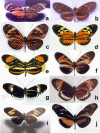Natural hybridization in heliconiine butterflies: the species boundary as a continuum
- PMID: 17319954
- PMCID: PMC1821009
- DOI: 10.1186/1471-2148-7-28
Natural hybridization in heliconiine butterflies: the species boundary as a continuum
Abstract
Background: To understand speciation and the maintenance of taxa as separate entities, we need information about natural hybridization and gene flow among species.
Results: Interspecific hybrids occur regularly in Heliconius and Eueides (Lepidoptera: Nymphalidae) in the wild: 26-29% of the species of Heliconiina are involved, depending on species concept employed. Hybridization is, however, rare on a per-individual basis. For one well-studied case of species hybridizing in parapatric contact (Heliconius erato and H. himera), phenotypically detectable hybrids form around 10% of the population, but for species in sympatry hybrids usually form less than 0.05% of individuals. There is a roughly exponential decline with genetic distance in the numbers of natural hybrids in collections, both between and within species, suggesting a simple "exponential failure law" of compatibility as found in some prokaryotes.
Conclusion: Hybridization between species of Heliconius appears to be a natural phenomenon; there is no evidence that it has been enhanced by recent human habitat disturbance. In some well-studied cases, backcrossing occurs in the field and fertile backcrosses have been verified in insectaries, which indicates that introgression is likely, and recent molecular work shows that alleles at some but not all loci are exchanged between pairs of sympatric, hybridizing species. Molecular clock dating suggests that gene exchange may continue for more than 3 million years after speciation. In addition, one species, H. heurippa, appears to have formed as a result of hybrid speciation. Introgression may often contribute to adaptive evolution as well as sometimes to speciation itself, via hybrid speciation. Geographic races and species that coexist in sympatry therefore form part of a continuum in terms of hybridization rates or probability of gene flow. This finding concurs with the view that processes leading to speciation are continuous, rather than sudden, and that they are the same as those operating within species, rather than requiring special punctuated effects or complete allopatry. Although not qualitatively distinct from geographic races, nor "real" in terms of phylogenetic species concepts or the biological species concept, hybridizing species of Heliconius are stably distinct in sympatry, and remain useful groups for predicting morphological, ecological, behavioural and genetic characteristics.
Figures



Similar articles
-
Genetic analysis of a wild-caught hybrid between non-sister Heliconius butterfly species.Biol Lett. 2007 Dec 22;3(6):660-3. doi: 10.1098/rsbl.2007.0401. Biol Lett. 2007. PMID: 17804337 Free PMC article.
-
A hybrid zone provides evidence for incipient ecological speciation in Heliconius butterflies.Mol Ecol. 2008 Nov;17(21):4699-712. doi: 10.1111/j.1365-294X.2008.03934.x. Epub 2008 Sep 30. Mol Ecol. 2008. PMID: 18828780
-
Divergence with gene flow across a speciation continuum of Heliconius butterflies.BMC Evol Biol. 2015 Sep 24;15:204. doi: 10.1186/s12862-015-0486-y. BMC Evol Biol. 2015. PMID: 26403600 Free PMC article.
-
Review. Hybrid trait speciation and Heliconius butterflies.Philos Trans R Soc Lond B Biol Sci. 2008 Sep 27;363(1506):3047-54. doi: 10.1098/rstb.2008.0065. Philos Trans R Soc Lond B Biol Sci. 2008. PMID: 18579480 Free PMC article. Review.
-
Introgression of wing pattern alleles and speciation via homoploid hybridization in Heliconius butterflies: a review of evidence from the genome.Proc Biol Sci. 2012 Dec 12;280(1752):20122302. doi: 10.1098/rspb.2012.2302. Print 2013 Feb 7. Proc Biol Sci. 2012. PMID: 23235702 Free PMC article. Review.
Cited by
-
Gene flow between Drosophila yakuba and Drosophila santomea in subunit V of cytochrome c oxidase: A potential case of cytonuclear cointrogression.Evolution. 2015 Aug;69(8):1973-86. doi: 10.1111/evo.12718. Epub 2015 Aug 8. Evolution. 2015. PMID: 26155926 Free PMC article.
-
Genomic divergence during speciation: causes and consequences.Philos Trans R Soc Lond B Biol Sci. 2012 Feb 5;367(1587):332-42. doi: 10.1098/rstb.2011.0263. Philos Trans R Soc Lond B Biol Sci. 2012. PMID: 22201163 Free PMC article.
-
Genetic analysis of a wild-caught hybrid between non-sister Heliconius butterfly species.Biol Lett. 2007 Dec 22;3(6):660-3. doi: 10.1098/rsbl.2007.0401. Biol Lett. 2007. PMID: 17804337 Free PMC article.
-
Assessing Genomic Admixture between Cryptic Plutella Moth Species following Secondary Contact.Genome Biol Evol. 2018 Nov 1;10(11):2973-2985. doi: 10.1093/gbe/evy224. Genome Biol Evol. 2018. PMID: 30321345 Free PMC article.
-
Non-equilibrium estimates of gene flow inferred from nuclear genealogies suggest that Iberian and North African wall lizards (Podarcis spp.) are an assemblage of incipient species.BMC Evol Biol. 2008 Feb 26;8:63. doi: 10.1186/1471-2148-8-63. BMC Evol Biol. 2008. PMID: 18302778 Free PMC article.
References
-
- Anderson TJC, Romero-Abal ME, Jaenike J. Genetic structure and epidemiology of Ascaris populations: patterns of host affiliation in Guatemala. Parasitol. 1993;107:319–334. - PubMed
-
- Anderson TJC, Romero-Abal ME, Jaenike J. Mitochondrial DNA and Ascaris epidemiology: the composition of parasite populations from individual hosts, families and villages. Parasitol. 1995;110:221–229. - PubMed
Publication types
MeSH terms
Substances
LinkOut - more resources
Full Text Sources

